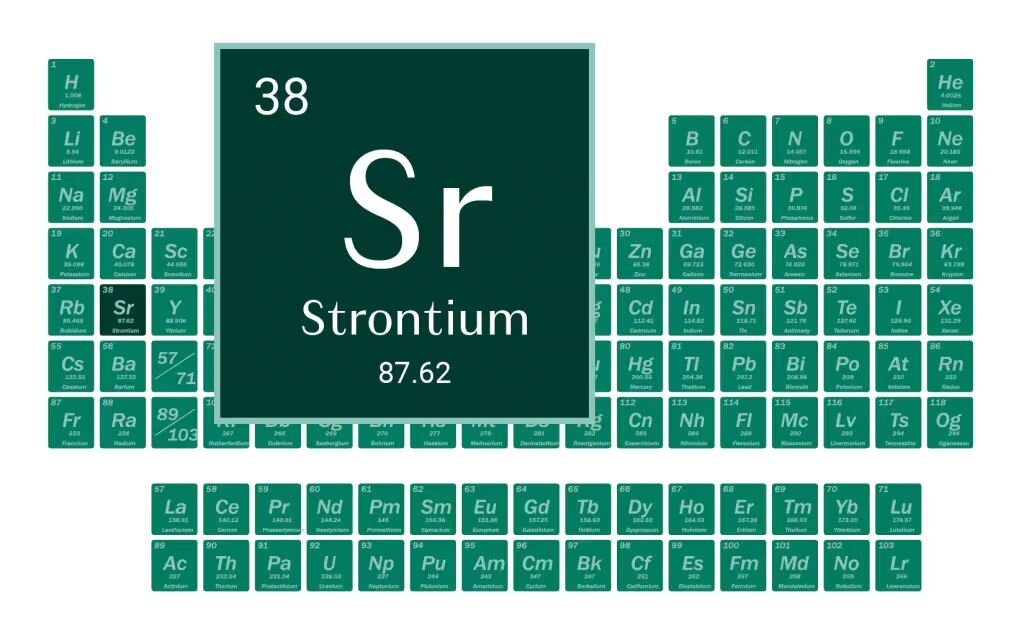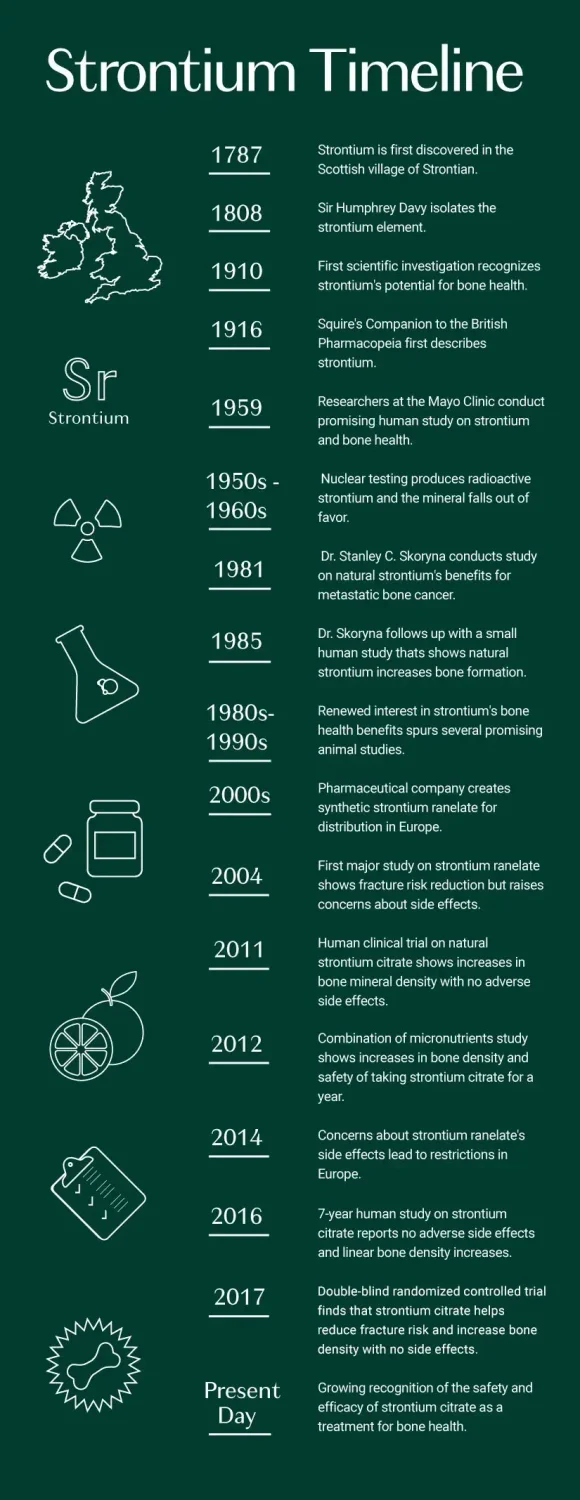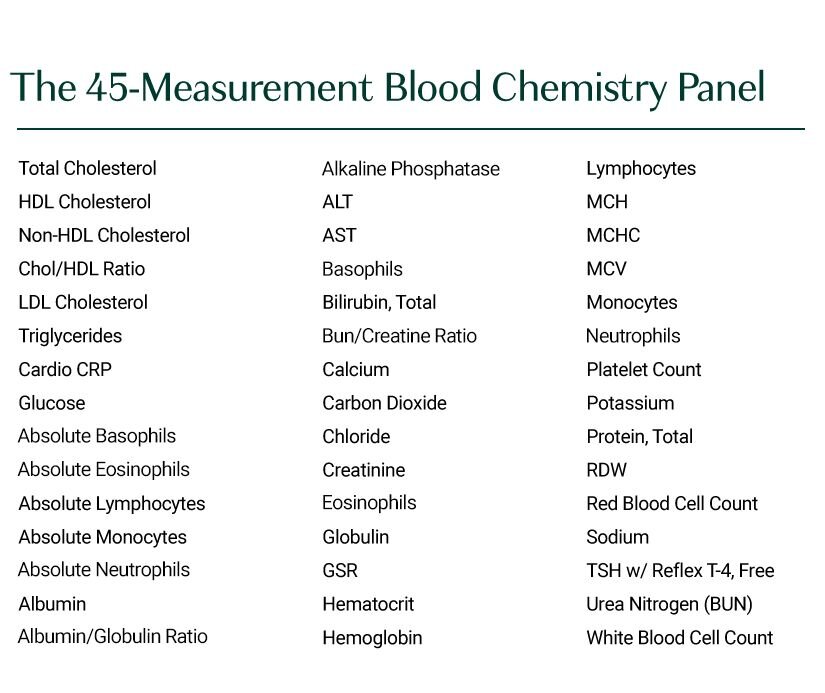Is Strontium Safe and Effective for Bone Health?

Many people question the safety of strontium. You may have concerns about this yourself. After all, there’s a lot of conflicting information out there, and it’s not always easy to tell fact from fiction…
So in this article, we’re going to clear up the safety concerns about strontium supplementation once and for all. You’ll discover:
What is Strontium?
Strontium is a natural trace mineral. It’s a member of group two of the periodic table of elements — right below calcium and magnesium!

Strontium can be found in soil, water, and everyday foods like grains, beans, spinach, lettuce, and celery.
It’s also naturally present in your body. Like calcium, 99% of the strontium in your body is in your bones. In fact, these two minerals are closely related. They’re both absorbed in your gut, incorporated into bone the same way, and eliminated from your body through your kidneys.
Strontium takes after its relative calcium when it comes to bone health benefits too. Years of research show this mineral has incredible bone-strengthening properties. In fact, research on strontium and bone health showed promise as early as 1910!
So let’s have a closer look at the research in question…
History of Strontium Supplements

Click on the dates below for additional details on that period!
1787
1808
1910
1916
1955
1959
1950s-1960s
1981-1985
Strontium Forms, Compared
There are several forms of strontium, and not all of them are equally beneficial.
The reason there are different forms of strontium, is that like calcium and magnesium, this mineral can’t exist by itself. It has to bond with other materials to form a stable salt. (A stable salt is a compound that has an equal number of positively charged and negatively charged ions.)
These salts can be formed with natural materials like strontium lactate, strontium carbonate, and strontium citrate.
Or strontium salts can be made in a laboratory with synthetic materials. The most common example of this is the prescription drug strontium ranelate, which is made with ranelic acid. And of course, there’s also radioactive strontium, which is an unstable form of the mineral.
The key point to understand here is that taken at the right dosage and with the right complementary nutrients, natural strontium salts are safe and extremely beneficial for your bones. (We’ll go over how to get the most out of your strontium supplement a little later on!)
On the other hand, strontium ranelate and radioactive strontium come with safety concerns and can cause adverse side effects.
Let’s take a closer look at each of the different forms of strontium:
Natural Strontium Salts (Strontium Citrate)
Strontium Ranelate (Drug)
Radioactive Strontium
Strontium Safety and Efficacy
As noted in the history section, the vast majority of research on strontium from the past decade was conducted using strontium ranelate.
And yes, these studies show that strontium ranelate can benefit bone health. In fact, two large randomized controlled trials (RCTs) on strontium ranelate [1, 2] showed that it significantly reduced fracture risk and increased BMD.
Another study analyzed data from these two RCTs and determined that strontium ranelate reduced vertebral fracture risk by 40% after three years. Notably, this effect was independent of individual risk factors for osteoporotic fractures like baseline BMD, family history, and baseline body mass index. In other words, strontium was able to reduce fracture risk even without taking into account bone density. A pretty amazing feat!
So these studies suggest that strontium is effective at strengthening bone over long periods of time. And even though these studies were on strontium ranelate, the positive effects can be attributed to the strontium portion of the drug, and not the ranelic acid.
Indeed, experts report that, “It appears to be the strontium portion of the molecules which exerts most or all of the positive effect on bone.”
The problem is the side effects that come with strontium ranelate. The ranelic acid in strontium ranelate detracts from strontium’s good work, and quite frankly, the risk associated with this treatment is not worth the potential gain.
But what if you replace ranelic acid with a natural binder like citric acid? Well, in theory, you’d be left with all the incredible bone health benefits of strontium, and none of the adverse side effects of its drug form. That’s exactly what modern research on natural strontium citrate supplementation shows.
To date, there are four human clinical studies that demonstrate strontium citrate’s safety and efficacy. Now, please note that though strontium citrate has a remarkable safety profile, there’s one contraindication, which we’ll go over a little further down the page.
But first, here’s a summary of the modern studies on strontium citrate:
Study 1: Changes in Total Body Bone Mineral Density Following a Common Bone Health Plan With Two Versions of a Unique Bone Health Supplement: A Comparative Effectiveness Study
Study 2: Combination of Micronutrients for Bone (COMB) Study: Bone Density After Micronutrient Intervention
Study 3: A 7-Year Longitudinal Trial of the Safety and Efficacy of a Vitamin/Mineral Enhanced Plant-Sourced Calcium Supplement
Study 4: Melatonin-Micronutrients Osteopenia Treatment Study (MOTS): A Translational Study Assessing Melatonin, Strontium (Citrate), Vitamin D3 and Vitamin K2 (MK7) on Bone Density, Bone Marker Turnover and Health Related Quality of Life in Postmenopausal Osteopenic Women Following a One-Year Double-Blind RCT and on Osteoblast-Osteoclast Co-Cultures
Strontium Myths
Now, you’ve seen an abundance of research that shows natural strontium citrate is a safe and effective way to increase bone density.
You’ve also discovered the vast difference between natural strontium citrate and synthetic strontium ranelate, which comes with a long list of side effects.
But you may still be wondering whether other claims you’ve heard about strontium are true. For example, there’s a common misconception that strontium skews DEXA results. But the truth is, the amount that strontium impacts DEXA results is insignificant.
Another common misconception is that strontium can actually cause bones to become more fragile and prone to fracture. But this is based merely on speculation and not any kind of scientific evidence.
On the contrary, strontium has been shown to reduce fracture risk independent of bone density! So regardless of any increases in bone density you may see, strontium can help you avoid a fracture… which is the ultimate goal of any regimen for improving bone health.
For a more detailed explanation of these misconceptions, check out our article, “Strontium Side Effects Are Overblown: Get the Facts” written by our Resident Bone Health Expert, Lara Pizzorno.
Strontium Bone Health Benefits
Strontium is truly an exceptional mineral for bone health. In fact, it can do something no other mineral in the world can…
As we touched on earlier, strontium both stimulates the rate of new bone building, and slows the rate of bone break down. This powerful dual-effect is no doubt a big contributor to the bone density increases seen in clinical studies using strontium citrate.
Plus, strontium has four other important benefits for bone health too. To read more about all of the science-backed benefits of strontium, visit our “Strontium Benefits” page.
Strontium Rich-Foods
As mentioned at the beginning of this article, strontium is atrace mineral! So traces of strontium can be found in food, but it’s not overly abundant. That said, some foods are richer sources of strontium than others.
To find out how to incorporate strontium into your diet effectively, visit our “Strontium-Rich Foods” page.

Strontium Contraindications
As we’ve seen, strontium citrate is safe and adverse side effect-free for the majority of people. But there’s one exception to the rule!
If you have chronic kidney disease, you may want to moderate or refrain from strontium supplementation depending on the severity of the condition. This is because strontium is eliminated by the kidneys. And of course, people with this condition can’t remove waste as well through their kidneys, so an excess of strontium can accumulate in the body.
What’s more, if you’re on dialysis for kidney disease, dialysis fluid can contain high concentrations of strontium. So not surprisingly, some dialysis patients have elevated bone strontium concentrations and a higher strontium to calcium ratio in their bones. This can contribute to osteomalacia — a condition where the bones become soft.
Note that osteomalacia is frequently seen in individuals with kidney disease who aren’t on dialysis and have normal bone strontium levels. This is because failing kidneys lose their ability to activate vitamin D, which is key for calcium absorption. In addition, they’re less able to reabsorb calcium that’s passing through the kidneys. So calcium is doubly hard to come by! All this to say, more often than not, strontium has nothing to do with osteomalacia seen in chronic kidney disease.
The best test to measure kidney function is called estimated glomerular filtration rate (eGFR). It can help determine what stage of kidney disease you’re at. Simply put, the lower your eGFR, the more impaired your kidney function.
For context, here’s a table from the National Kidney Foundation that shows what a normal eGFR number is based on age:
Age | Average estimated eGFR |
|---|---|
Age 20-29 | Average estimated eGFR 116 |
Age 30-39 | Average estimated eGFR 107 |
Age 40-49 | Average estimated eGFR 99 |
Age 50-59 | Average estimated eGFR 93 |
Age 60-69 | Average estimated eGFR 85 |
Age 70+ | Average estimated eGFR 75 |
The National Kidney Foundation also reports that an eGFR below 60 for three or more months indicates chronic kidney disease.
So if your eGFR is 60 or lower, our Resident Bone Health Expert, Lara Pizzorno, recommends you cut your dose of Strontium Boost in half — take one capsule rather than two capsules daily. This is to “lighten the load” on your kidneys.
But please note, it’s always best to check with your medical professional as recommendations may vary on a case by case basis.
As a general rule, however, you may want to moderate or forgo strontium supplementation if:
It’s worth noting that strontium is also not advised for children. It may alter the architecture of rapidly growing bones, and no studies have been done using high doses of strontium on children.
How to Get the Most Out of Your Strontium Supplement
Take 680 mg of strontium citrate a day
If you have low bone density, you’ll get the most benefit from a dose of 680 mg of strontium citrate a day. Why 680 mg? If you recall, the majority of human clinical studies on strontium citrate were conducted using this dose. These studies showed that 680 mg of strontium citrate a day was both safe and effective at increasing bone density. Note: That’s why this is the daily dose provided in two capsules of Strontium Boost.
Separate calcium and strontium intake by at least two hours
Calcium and strontium are chemically similar minerals, and they use the same absorption pathway. So if you take your calcium and strontium at the same time, they would compete for absorption — a competition that calcium always wins. That means, you wouldn’t end up benefiting from your strontium supplement at all! This issue is easily avoided by taking your calcium and strontium supplements at least two hours apart. For example, we recommend taking two capsules of AlgaeCal Plus at breakfast and two capsules at lunch. Then, two capsules of Strontium Boost before bed. To make this easier to remember, here’s a printable PDF with instructions on “How to Take AlgaeCal Products”.
Limit processed food consumption
Phosphate (a chemical compound that contains phosphorus, often a salt) significantly lowers strontium absorption. Phosphates are used as preservatives in most processed foods, so make sure you read nutrition labels closely. Most often, phosphates are found in foods like sodas, sweet bakery products, cereals, crackers, pizza, cured meats, poultry, processed vegetables, egg products, candy, and chocolate.
Include all essential bone-building nutrients
Although strontium offers remarkable bone-supporting benefits, it’s by no means a “magic bullet”. And as you can see from the research on strontium citrate, it’s best to use it in combination with other nutrients! That’s because bone-building is a team effort. Your bones require 13 essential minerals (one of which is strontium) and 3 vitamins. These include calcium, magnesium, boron, and vitamins D3, K2, and C — to name just a few! AlgaeCal’s Bone Builder Pack (AlgaeCal Plus and Strontium Boost) provides all of these nutrients in the perfect proportions to support strong, healthy bones.
Safely and Naturally Reclaim Your Bone Density with Strontium
Strontium’s bone health benefits have never been in question. Its safety, on the other hand, has…
But the key takeaway here is that natural strontium citrate is both safe and extremely beneficial for your bones. And that anyone who questions the safety of natural strontium is confusing it with the two other kinds: Strontium ranelate and radioactive strontium.
Natural forms of strontium have been safely used in medicine for over 100 years. Indeed, studies demonstrated strontium’s bone health benefits as early as 1910. Unfortunately, due to a case of “mistaken identity” strontium fell out of favor in the 1950s.
And again, in the 21st century, natural strontium became confused with strontium ranelate — a synthetic version with many potential adverse side effects.
Thankfully, there’s a growing pool of clinical evidence to support the safety and efficacy of natural strontium citrate. Four human clinical studies from the last decade have demonstrated that strontium citrate helps increase bone density, without causing any adverse side effects, even when taken for a prolonged period of time.
The bottom line? Strontium citrate (Strontium Boost) is a natural, safe, and scientifically validated way to support your bone health. In fact, it’s guaranteed to increase your bone density in as little as six months when taken with AlgaeCal Plus.
YES! I want to build brand-new youthful bone now!
Special Introductory Offer Today + Free US Shipping
Loading...













